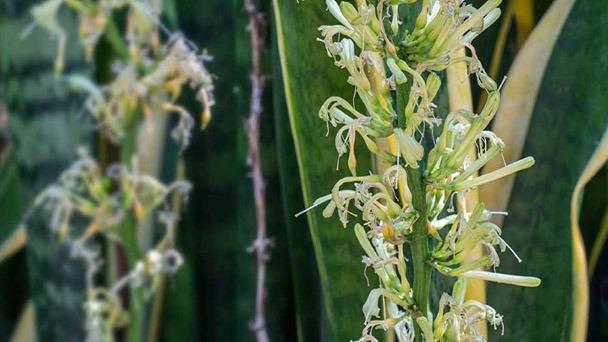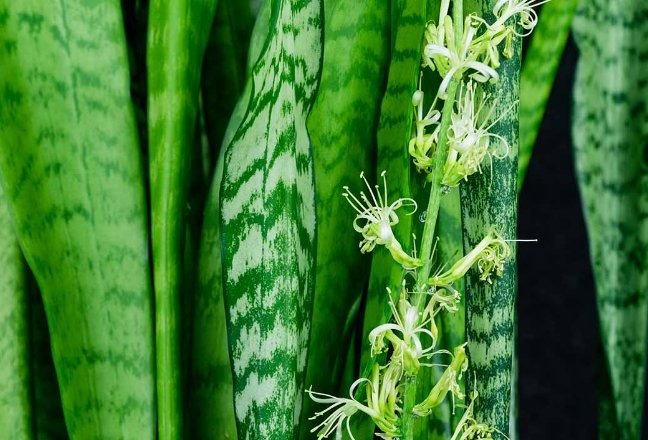How to Get a Snake Plant to Bloom with Simple Ways
Written by Ivy
Dec 16 2022

The snake plant's stunning but elusive flower, not its striking appearance, is what makes it most distinctive. Snake plants do bloom, as you might expect.
If your snake plant is a blooming variety, you might find a flower among the leaves one day. There are a few ways to encourage your snake plant to produce its enigmatic blooms, however, if you want to force a flower out on your own.
The two most important factors for a snake plant to flower are lighting and maturity. Usually, these plants take several years to reach full bloom. Given that they don't receive as much sun as they would in the wild, even older Sansevierias kept indoors might not produce flowers.
Do Snake Plants Flower?
Yes is the simple reply to the query. If the conditions are right, they do! This occurs once a year, typically in the spring or summer. Though extremely unlikely, it is still a possibility. You also have to bear the fact in mind that if you have grown Sansevieria trifasciata ‘Hahnii,' then it won't bloom, no matter what.
Sansevieria Flower Appearance
Occasionally, you might notice your plant blooming. First, you'll notice a stalk developing.
Overlooking the leaf tips of your sansevieria, this stalk can reach a maximum height of three feet. In most cases, there will be just one stalk.
Dozens of tiny tubular florets with thin petals, which are arranged in clusters, are embedded in these stalks. These tiny flowers will resemble lily or honeysuckle blossoms.
Some cultivars fail to develop stalks. Instead, they create substantial clusters of florets at the base of the plant.
Both their blooms and snake plants come in a range of hues. These hues typically range from white and cream to greenish-white or even yellow. The petals stand out in contrast to the colorful leaves of the plant.
Despite being infrequent, the blooms are stunning to look at and have a potent scent.
How to Make Your Snake Plant Flower
Light
Although even the most careless plant parents can successfully care for snake plants, they are known for being easygoing plants. Typically, snake plants can grow in both full sun and shade, as well as other types of lighting.
However, snake plants prefer continuous, indirect sunlight. Flowers need a lot of energy to grow, as gardeners are aware, and light is the source of that energy.
Remove your snake plant from the dim areas of your house to improve the likelihood that it will bloom. Instead, put it in front of a sheer curtained window so that it receives plenty of bright light all day long.
Water
Snake plants can survive with very little water. Due to their ability to store water in their leaves, they are regarded as semi-succulent plants and have relatively low water needs.
Snake plants also detest having their feet wet, and they prefer dry soil to muddy or wet soil. The leaves may split and rot if they are overwatered. In spite of this, protracted droughts can be harmful.
The best time to water snake plants is when the soil feels completely dry to the touch. This can occur as infrequently as twice a month, depending on the temperature and climate. You should water your snake plant even less in the winter.
According to popular belief, snake plants will bloom under stress as long as their light needs are met. Some people contend that watering the snake plant as little as possible causes it enough stress to bloom. You can try this trick if you don't mind taking a chance on other possible problems brought on by underwatering.

Soil and Nutrients
Snake plant soil needs to be extremely light and quick to drain. As previously mentioned, snake plants are susceptible to root rot if the soil is overly wet. The addition of some river sand to your potting mix will greatly enhance the drainage and aeration of your soil.
The majority of the time, snake plants don't need extra nutrients to thrive. However, adding a high phosphorus fertilizer to the soil may increase your snake plant's likelihood of flowering. Use sparingly because excessive use may result in nutrient imbalances in the soil, which will have a detrimental effect on growth.
Temperature
Snake plants are indigenous to West Africa and favor tropical climates. Zones 9 through 11 of the USDA are where they do best. Since they cannot survive temperatures below 50°F, outdoor snake plants must be overwintered indoors.
While a little stress might encourage your snake plant to bloom, exposing it to drafts and freezing temperatures is harmful. Higher temperatures or less water are far safer alternatives that won't instantly kill your plant and may be repairable later if the damage is not severe.
Age
When and if your snake plant blooms depends a lot on how old the plant is. It is extremely rare for younger plants to bloom.
If the right circumstances are present, older, more established plants are more likely to bloom.
The stress on established plants is also increased by their propensity to become root- or pot-bound. Snake plants have a tendency to fill the entire pot when they are neglected and receive adequate light. As a result of the smaller space, the snake plant concentrates more of its energy on producing blooms rather than leaves.
How Long Do Snake Plant Blooms Last?
The flowers may remain in bloom for a few weeks to a month. When the flower stalks die back, be sure to prune them from the base to conserve energy and maintain a tidy appearance.
Do They Have a Scent?
Snake plant flowers emit a potent fragrance at night.
They also contain a sweet, gooey nectar, which condenses on the stems to form dew drops. These have a potent and alluring scent.
The blossoms swell in the morning and close at night.
Do Snake Plants Die After Flowering?
No, once they bloom, the plants will continue to thrive. Orange berries will develop from the flowers, and the stalks will eventually die.
Does the Snake Plant Die After Flowering?
After blooming, Sansevieria won't perish. The flowers develop into orange berries. This snake plant's indoor blooms surprised the owner.
Why Do They Flower So Rarely?
Sansevieria plants rarely bloom, but it does happen occasionally. Your plant may have experienced some stress, which is why the flowers are produced. But relax; neither the plant's growth nor the rest of it will be harmed.
Only one plant in a hundred will have this particular bloom, which is unique.
You shouldn't push it to bloom. It could take more than ten years for another bloom to appear, depending on the specific conditions your snake plant is growing in.
Should You Do Anything About It?
On your plants, the flowers have no impact. However, they frequently appear when people are under stress. Your plant's root-boundness is frequently to blame.
If it's been a while since you repotted your snake plant, you might want to think about it. Rarely, snake plants can become so root-bound that they break the pot they are growing in.
If the roots are growing out of the pot's bottom or the soil in the pot is being completely absorbed by the roots, the plant probably needs to be repotted. The pot might even start to bulge or crack.
Conclusion
Because snake plant flowers are so uncommon, few people even know the plant can bloom. Sometimes these flowers simply appear out of nowhere.
Snake plants don't need much attention to survive, and some people even believe that neglect encourages the plant to grow. The sweet, elusive white blooms can eventually be obtained by being patient, taking care of this plant's lighting requirements, and adding some healthy stress.
The nectar from these flowers is thick and sticky, and you should be aware of their potent aroma. Pests frequently become attracted to this nectar, which can create a big mess. In addition, if and when your snake plant decides to flower, these uncommon blooms are a real treat.
FAQs
Do Snake Plants Bloom When Stressed
Snake plants require little care to survive, and some people even believe that neglect encourages the plant to grow. Ultimately, patience and meeting this plant's light needs, with a bit of healthy stress added in, can result in the sweet, elusive white blooms.
Is It Bad If a Snake Plant Flowers
A snake plant typically blooms when it is slightly stressed, neglected, and root-bound. You might think that flowering is bad for your snake plant even though it is uncommon and brought on by stress. However, there are no studies or facts about flowering harming them
Read more about snake plants!
- What Are the Benefits of Snake Plants - Everything You Need to Know
- Is Snake Plant Poisonous to Cats
- How to Reroot A Snake Plant With Simple Steps
- How Much Light Does Snake Plant Need
- How Often to Water Snake Plant (Sansevieria Trifasciata)
- How To Fix Snake Plant Root Rot (Sansevieria Trifasciata)
- Underwatered Snake Plant (Sansevieria Trifasciata) - Signs And How To Fix
- How To Save Overwatered Snake Plant (Sansevieria Trifasciata)
Latest Updated
- Benefits of Bugleweed - 7 Science-backed Health Benefits
- Bugleweed Dangers & Side Effects - Is It Poisonous?
- How to Plant Evergreen Trees - What You Should Know
- When to Plant Evergreens - Grow Guide for Evergreen Trees
- 12 Wonderful Evergreen Shrubs for Your Garden
- 12 Popular Evergreen Plants with Pictures for Beginners
- When And How To Prune A Lilac Bush Like a Pro
- How to Grow & Care for Lilac Vine (Hardenbergia Violacea)
- Japanese Lilac Tree (Syringa Reticulata) Care & Propagation Guide
- Shumard Oak Pros and Cons - What to Know
Popular Articles
- Winter maintenance of Antirrhinum Majus
- How to Grow Terminalia Mantaly Tree
- How to Grow and Care for Crossostephium Chinense
- How to grow Antirrhinum Majus in spring
- Peristeria Elata (Dove Orchid) Profile: Info & Care Guide
- Underwatered Snake Plant (Sansevieria Trifasciata) - Signs And How To Fix
- How to Care for Brazilian Jasmine Plant (Mandevilla Sanderi)
- How to Grow & Care for Graptopetalum Purple Delight in Summer
- Rosa Chinensis (China Rose): Plant Growing & Care Tips
- How to Care for Baby Sun Rose (Aptenia Cordifolia)